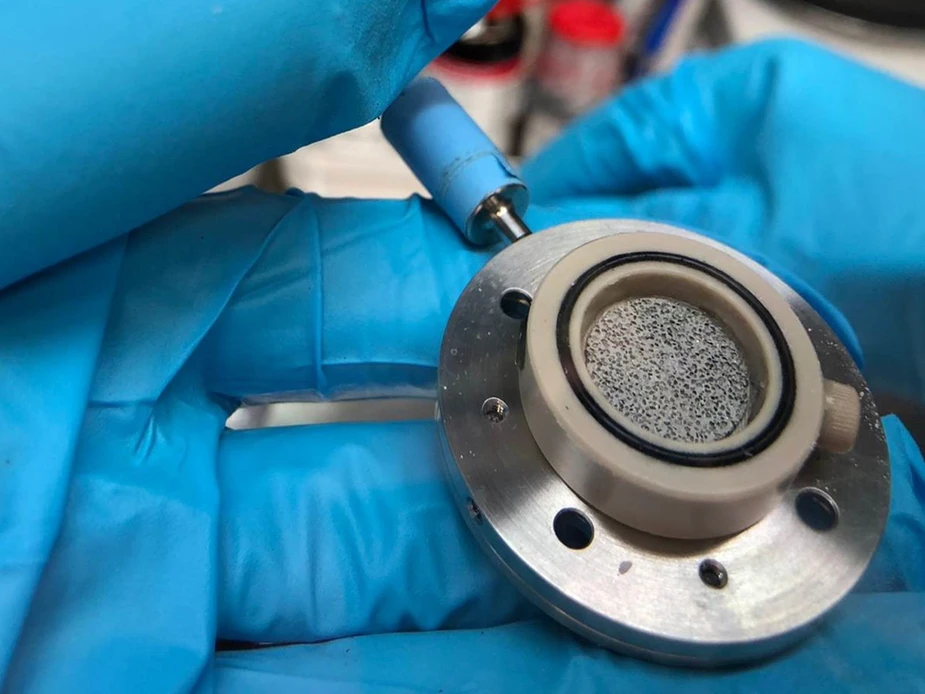Innovative battery electrode made from tin foam
The material could make lithium batteries more robust and efficient
Metal-based electrodes in lithium-ion batteries promise significantly higher capacities than conventional graphite electrodes. Unfortunately, they degrade due to mechanical stress during charging and discharging cycles. A team at HZB has now shown that a highly porous tin foam is much better at absorbing mechanical stress during charging cycles. This makes tin foam an interesting material for lithium batteries.
Modern lithium-ion batteries are typically based on a multilayer graphite electrode, with the counter electrode often made of cobalt oxide. During charging and discharging, lithium ions migrate into the graphite without causing significant volume changes in the material. However, the capacity of graphite is limited, making the search for alternative materials an exciting area of research. Metal-based electrodes, such as aluminium or tin, have the potential to offer higher capacity. However, they tend to expand significantly in volume when lithium is absorbed, which is associated with structural changes and material fatigue. Tin is particularly attractive because it’s capacity per kilogram is almost three times higher than graphite, and it is not a rare raw material but is available in abundance. One option for realising metal electrodes that ‘fatigue’ less quickly involves nanostructuring the thin metal foils. Another option is to use porous metal foams.
A team from the Helmholtz-Zentrum Berlin (HZB) has now studied various types of tin electrodes during the discharge and charging process using operando X-ray imaging, and developed an innovative approach to address this problem. Part of the experiments were carried out at the BAMline at BESSY II. The high-resolution radioscopic X-ray images were taken in collaboration with imaging experts Dr. Nikolai Kardjilov and Dr. André Hilger at HZB. ‘This allowed us to track the structural changes in the investigated Sn-metal-based electrodes during the charging/discharging processes,’ says Dr. Bouchra Bouabadi, first author of the study. With battery expert Dr. Sebastian Risse, she explored how the morphology of the tin electrodes changes during operation due to the inhomogeneous absorption of lithium ions.
Dr Francisco Garcia-Moreno produced the best version of the tin electrode: a tin foam with countless micrometre-sized pores. ‘We were able to show that the mechanical stress in such a tin foam during volume expansion is significantly reduced,’ says Dr Risse. This makes tin foams an interesting material for lithium batteries.
Garcia-Moreno has already studied numerous metal foams, including those used for components in the automotive industry and aluminium foams for battery electrodes. ‘The tin foams we developed at the TU Berlin are highly porous and a promising alternative to traditional electrode materials,’ he says. The structuring of the tin foams is crucial to reduce mechanical stress as much as possible. Tin foam technology could also be attractive from an economic point of view: ‘Although tin foam is more expensive than conventional tin foil, it offers a cheaper alternative to expensive nanostructuring, while being able to store significantly more lithium ions, thus enabling an increase in capacity.’
Publication:
Advanced Science (2025): Morphological Evolution of Sn-Metal-Based Anodes for Lithium-Ion Batteries Using Operando X-Ray Imaging
Bouchra Bouabadi, André Hilger, Paul H. Kamm, Tillmann R. Neu, Nikolay Kardjilov, Michael Sintschuk, Henning Markötter, Thomas Schedel-Niedrig, Daniel Abou-Ras, Francisco García-Moreno, Sebastian Risse
DOI: 10.1002/advs.202414892
Contact:
Helmholtz-Zentrum Berlin für Materialien und Energie
Dr. rer. nat. Sebastian Risse
Institute Electrochemical Energy Storage
+49 30 8062-43022
sebastian.risse(at)helmholtz-berlin.de
Dr. Francisco Garcia-Moreno
Microstructure and residual stress analysis department
+49 30 8062-42761
garcia-moreno(at)helmholtz-berlin.de
Press Officer:
Dr. Antonia Rötger
+49 30 8062-43733
antonia.roetger(at)helmholtz-berlin.de
Press release HZB, 24 February 2025
